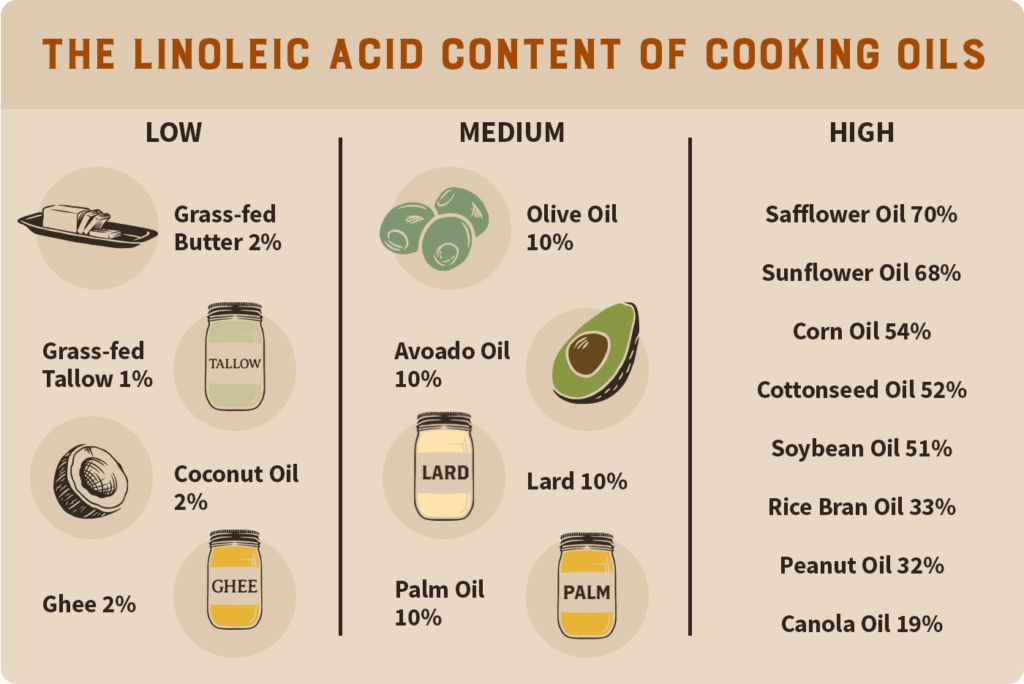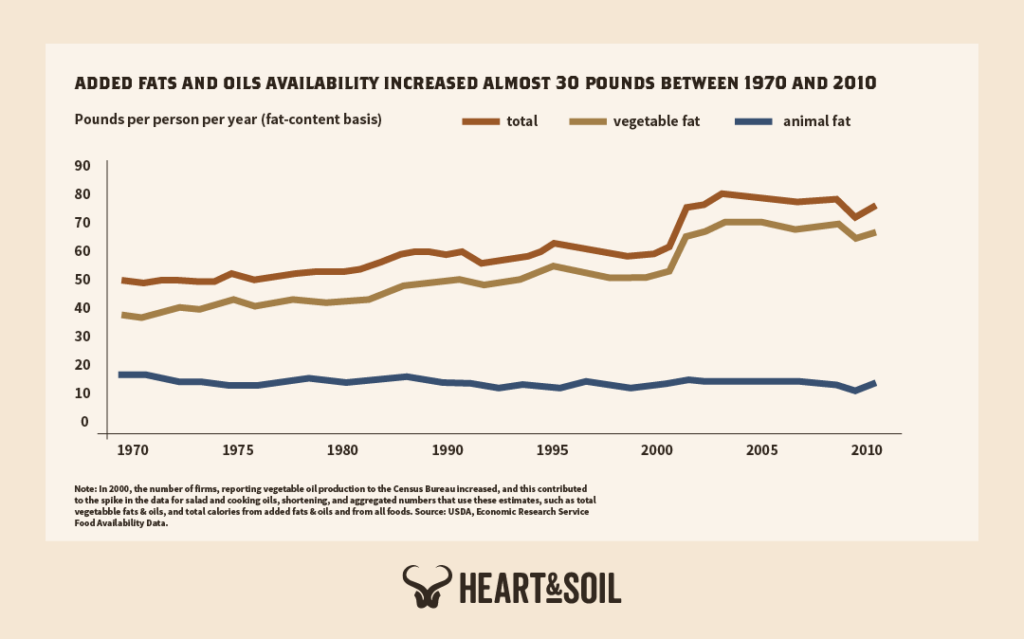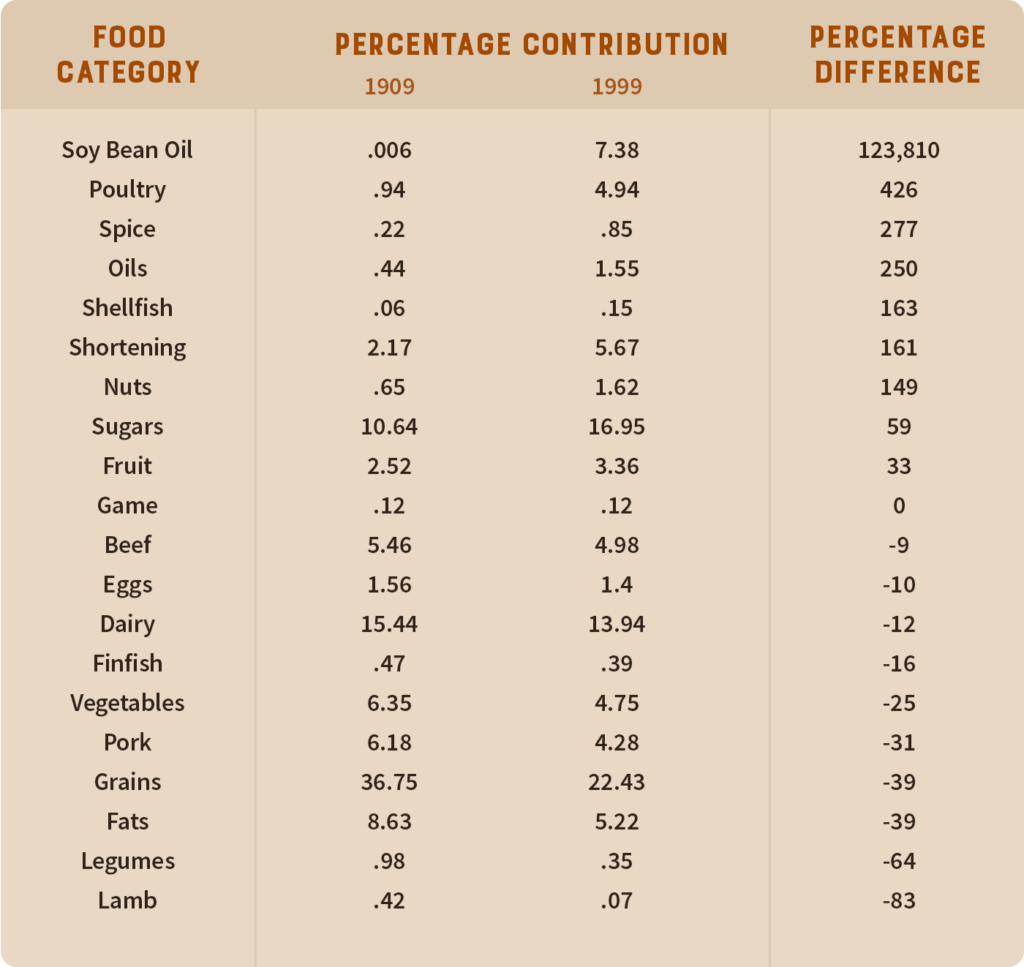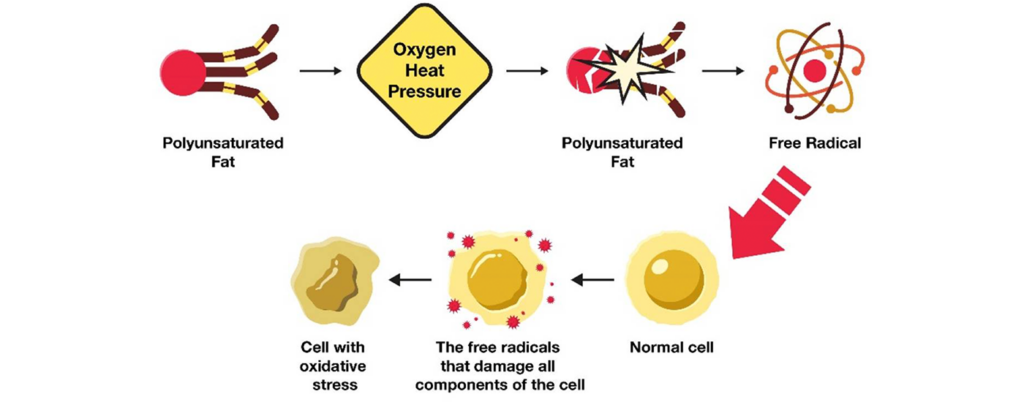PLEASE NOTE: The information in this blog is for educational purposes only. It is not a substitute for professional medical advice. Consult your healthcare provider if you’re seeking medical advice, diagnoses, or treatment.
A quick Google search on “Are seed oils bad for you?” will turn up dozens of resources on why they’re healthy and should be used instead of animal fats.
 Even though these recommendations have been made for decades, there’s a lack of high-quality evidence to support these claims.
Even though these recommendations have been made for decades, there’s a lack of high-quality evidence to support these claims.
Plus, conflicting evidence continues to emerge that seed oils contribute to the massive rise in chronic disease seen globally.
Like most health topics, it can be confusing to sift through the conflicting information.
Are seed oils something you should consume more of? Or are they one of many contributors to a population that’s getting sicker and sicker?
We’ll dive into a brief overview of seed oils and then discuss ten reasons why you may want to ditch these recent additions to the human diet!
What Are Seed Oils?
Seed oils (also called vegetable oils) are derived from the seeds of crops. Common seed oils include corn, canola, soybean, sunflower, rice bran, cottonseed, and safflower oil.
Seed oils are found in most packaged and processed foods, restaurants, infant formulas, and salad dressings. Take a look at the ingredient labels at the grocery store, and you’re likely to see one (or multiple) of the oils listed above!
Seed oils can contain high levels of linoleic acid, an essential omega-6 polyunsaturated fatty acid (PUFA), meaning it has to be obtained through food (1). Linoleic acid is the most abundant PUFA in the typical, highly-processed Western diet (2).

Linoleic acid is not inherently bad, but the excessive amounts consumed today may contribute to numerous issues. We have an estimated need of 1-2% of daily energy for normal growth and development, yet the average intake is generally much higher (3).
Seed oils have become a staple in the modern human diet for various reasons, such as the emergence of modern agriculture, vegetable oil industries, and processed foods.
The diet-heart hypothesis was also introduced in the 1950s and stated that saturated fats cause cardiovascular disease.
Despite weak evidence for this hypothesis, institutions like the American Heart Association began recommending that individuals reduce their consumption of saturated fats (as found in meat and dairy) to prevent cardiovascular diseases (4).
These recommendations were made with little to no understanding of the short or long-term effects on health (5).
Since these guidelines gained traction in the 1960s, over 20 studies have shown insufficient evidence to continue suggesting that individuals avoid saturated fats (6). Somehow, guidelines to increase the intake of polyunsaturated fatty acids (PUFAs) from plant oils and reduce saturated fat intake are still in effect today (7).
Global demand for seed oils is projected to grow 46% by 2050 and the market value for these oils was over $166 billion in 2021 (8, 9).
Demand for seed oils is growing, yet so are the questions about their safety!
Are Seed Oils Bad For You? 10 Concerning Insights
While seed oil consumption is one of many recent diet and lifestyle changes that can impact your health, it’s a significant change that can have serious consequences. Still, seed oils are generally viewed unquestionably as “healthy.”
Here are some crucial points to consider:
1. People are consuming far more omega-6’s than omega-3’s
The ratio of omega-6 to omega-3 consumption by humans was around 4:1 (or less) until about 100 years ago (10).
Current estimates differ, but this ratio appears to be anywhere from 15-20:1 (11, 12) or up to 50:1 (13). Seed oils are the primary contributor to these changes.

Since 1970, the availability of vegetable oils high in omega-6 has steadily increased while animal fats (like butter and tallow) have largely stayed the same.
A high omega-6/omega-3 ratio may promote cardiovascular disease, cancer, and autoimmune diseases, whereas a lower ratio appears to protect against these challenges (14, 15, 16).
2. Linoleic acid intake has risen dramatically in the last 100-150 years
Like many processed foods, seed oils are a recent addition to the human diet. Seed oils, in particular, have seen a meteoric rise in prominence. Current global consumption is around 200 million tons per year (17).
Take soybean oil, for example. During the 20th century, it went from an estimated 0.006% of energy intake to 7.38% in the US (18). That’s a more than 1000% increase!

Soybean oil also contains more than 50% linoleic acid (19).
Since the agricultural revolution 10,000 years ago, human genes have changed about 0.005% (20). Yet, the typical Western diet would’ve been largely unrecognizable back then.
Americans consume, on average, 40 grams (3 tablespoons) of vegetable oil daily (21). This is far more linoleic acid than your ancestors would’ve ever obtained from food sources like meat, fruit, vegetables, or nuts.
3. Excess linoleic acid intake may contribute to a variety of chronic diseases
Chronic diseases like obesity, cancer, cardiovascular disease, and type 2 diabetes are rising exponentially across the globe.
A high omega-6 to omega-3 ratio or excessive intake of omega-6 PUFAs has been shown to promote the development of cardiovascular disease, autoimmune diseases, and cancer (22, 23).
Excess omega-6 fatty acids from the diet can alter the balance of pro and anti-inflammatory agents in the body, which may result in chronic inflammation and an increased risk of these diseases (24).
4. Linoleic acid is prone to oxidation
Compared to whole-food sources of omega-6 (like nuts, seeds, and vegetables), seed oils are more susceptible to oxidation (25).
What does this mean?

So, linoleic acid is vulnerable to pressure, heat, and oxygen damage and can convert into harmful metabolites called OXLAMs or OXAAMs, which can damage stem cells, DNA, and mitochondria (26, 27).
OXLAMs are thought to play a central role in atherosclerosis (plaque buildup within the arteries) (28).
5. Seed oils appear to play a role in the current global obesity epidemic

Genetic, lifestyle, and environmental factors lead to obesity, but diet is one of the most relevant considerations.
The obesity epidemic doesn’t appear to be from genetics as it’s a recent occurrence in a wide range of populations (29).
The US has seen about a 2.5x increase in linoleic acid stored in adipose tissue (body fat) since the 1950s (30). Another study found that linoleic acid in adipose tissue increased by 136% from 1959-2008 (31). These concentrations are reflective of dietary intake.
By 2030, an estimated 50% of Americans are projected to be obese, and soybean oil is gathering steam as a key contributor, given it’s used heavily in processed foods, salad dressings, and restaurants.
A study on mice found that while a diet rich in soybean oil has some benefits, it leads to obesity, liver injury, and diabetes compared to a diet rich in coconut oil (32).
Obesity and inflammation appear to play a role in nearly every chronic disease (33). Obesity, in particular, can then contribute to hypertension, type 2 diabetes, and autoimmune diseases.
6. Omega-6’s and omega-3’s compete within the body
Omega-3 and omega-6 PUFAs often have opposite effects on the body (34).
Omega-3’s are used by the body to lower or resolve inflammation, while omega-6 PUFAs increase inflammation (35)
Omega-3 and omega-6 fatty acids compete for the same enzymes, so excess omega-6 intake can even inhibit omega-3 creation (36).
Excessive intake of linoleic acid from seed oils may reduce the availability of EPA and DHA (two important omega-3 fatty acids)(37). An omega-3 insufficiency may also negatively affect brain development. DHA plays a critical role in brain development and function (38).
Both EPA and DHA levels are inversely related to coronary artery disease (39). This means that when EPA and DHA levels are high, incidences of this disease are low.
7. Choosing vegetable oils instead of saturated fats doesn’t appear to reduce the risk of heart disease
The main hypothesis for incorporating vegetable oils and reducing saturated fat intake was that it would reduce your risk for cardiovascular disease.
An analysis from 2011 published several key findings after looking at studies touting the benefits of linoleic acid against coronary heart disease (40).
These include:
- Both randomized and non-randomized trials failed to distinguish clearly between omega-3 and omega-6 PUFAs.
- Some or all of the inverse association between PUFAs and coronary heart disease may be due to “the healthy observer effect.” Meaning the effects of linoleic acid may be overestimated.
- They concluded that the top two tiers of evidence-based medicine (randomized control trials and prospective cohort studies) don’t support the population-wide advice calling for increased linoleic acid consumption.
Another meta-analysis found that the risk of coronary heart disease generally increased with omega-6 PUFA interventions (41).
Recently recovered unpublished data from The Sydney Diet Heart Study (conducted from 1966-1973) showed that swapping saturated fat for linoleic acid-rich vegetable oil lowers cholesterol but increases the risk of death from coronary heart disease.
The Minnesota Coronary Experiment was another large-scale study conducted from 1968 to 1973 to test the effects of vegetable oil on heart disease. Although this study had several flaws, the findings also go against the diet-heart hypothesis (42).
8. The proposed benefits of linoleic acid may actually be in relation to EPA & DHA
There’s currently no evidence from clinical trials showing that replacing saturated fatty acids with omega-6 (without a rise in omega-3 PUFAs) lowers the risk of death or cardiovascular disease (43).
The benefits attributed to PUFAs as a whole may be from DHA and EPA specifically.
9. Linoleic acid can be transferred to breast milk

Like other fatty acids, linoleic acid accumulates in breast milk, and the PUFA status of infants is closely correlated to the mothers’ (44). Between 1970 and 2000, linoleic acid content of breast milk grew from 7 to 12% of total fatty acids (45).
A composition of 12% corresponds to 8% of energy intake (4-8x more than needed). This same study noted that excessive linoleic acid may negatively affect the brain.
Another study estimated that the linoleic acid content of breast milk in American women increased from about 7% in 1945 to around 15% in 1995 (46).
Seed oils are even used in some of the most popular infant formulas on the market!
10. Linoleic acid is challenging to eliminate from your body
As this article shows, excess linoleic acid from seed oils (and even pork or chicken products) can accumulate in your body.
Monogastric animals such as chickens and pigs (and humans) can’t eliminate or convert excess polyunsaturated fatty acids from the diet, so these PUFAs are stored in fat tissue.
The half-life of linoleic acid is around 680 days (nearly two years), meaning it would take about six years to replace 95% of the linoleic acid in your body with healthier fats (47, 48).
We now have generations of individuals raised on breast milk with excessive amounts of linoleic acid or seed oil-containing infant formulas, only to grow up on a diet of highly processed foods laden with seed oils.
What could possibly go wrong?
Seed Oils: One of Many Modern Issues to Navigate
Are seed oils bad for you, or is the hype around them overblown?
Human genetics take long periods of time to adapt, and it appears that we can’t quite keep up with the current onslaught of diet, lifestyle, and environmental changes.
While seed oils are not the only significant dietary change humans have seen in the past 100-150 years, evidence is mounting that not only are their beneficial health claims falling short, but they pose a major problem to our health.
Modest amounts of linoleic acid are needed to support your health, but the quantity in seed oils far exceeds these requirements.
Our diets and environments have changed dramatically, but this doesn’t mean we have to continue down a path of disease! Ditching seed oils is a simple way to improve your health radically.
Subscribe to future articles like this: